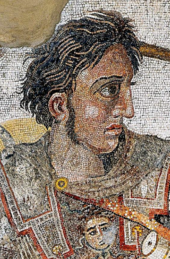Persia to Greece: Luxury & Power at the British Museum
When the Spartan general Pausanias came across Xerxes’ tent, leant to the commander Mardonius, after the victory over the Persians at Plataea in 479BC, according to Herodotus:
He commanded the bakers and chefs to cook him a meal of the kind they would have prepared for Mardonius. Once they had done as instructed, Pausanias gazed at the couches of gold and silver with their rich coverlets, and the magnificent feast weighing down the gold and silver tables, and was stupefied by the sheer spread of good things before him – and then, as a joke, he ordered his own servants to prepare a Laconian meal. So great was the contrast between this meal, when it had been readied, and the other, that Pausanias burst out laughing, and sent for the Greek generals…“Here is what their leader enjoyed every day – and yet, for all that, he came to rob us of the miserable portions you see here!” Herodotus 9.82 (Transl. Holland).
This outrage lies at the heart of the British Museum’s new exhibition, Persia to Greece: Luxury & Power which challenges the Greek attitude to Persian luxury seen as betraying moral corruption. Of course the idea that displays of wealth and extravagance convey power was not new, but it is one that made Greeks uncomfortable. Although towards the end of the century when one looks at her Acropolis after Pericles’ building program, it’s clear Athens was happy with such projections of power, in contrast to Sparta.
We are met with two busts, one marble the other bronze, which demonstrate the differences between the two cultures. The pair are Persian and Greek, finds from Cyprus, but both have elements of the other, and this theme continues throughout, and it’s these examples of intermingling between the two should not come as a surprise when one looks at the 6th and 5th centuries and the numerous Greek cities living under the Persian hegemony. A striking example is that from the BM’s own collection from the Nereid Monument showing the Greek king Arbinas of Lycia, dressed in Persian robes and shielded from the sun with a most un-Greek parasol.
Since we’re on robes, the exhibit has recreations of Persian costume. Challenging as it must be to make such outfits bearing in mind the tailors will be working off sculptures and written descriptions only, they really are beautiful items, with the brightly coloured ‘effeminate’ trousers particularly fetching, and a remarkable cloak embroidered with gold Achaemenid lions.
Other pieces are quite extraordinary, and new to me. Among them 5th century Athenian rhytons, pictured above, that were in use even after the Greco-Persian Wars – surprising that Athenians elites were drinking from such overtly Persian style cups, I had assumed it would have been the kylix only at the symposium. A special shout out to the vessel shaped like an ass – perfect for the Alcibiades of the time to drink themselves into a stupor before (allegedly) popping out for a bit of vandalism.
The Greco-Persian Wars of 490BC-479BC show Persian influence heading from east to west, but as we move through the rooms we arrive at Alexander’s invasion of the late 4th century, and influence shifts. Alexander famously embraced his new Persian customs, even down to the practice of proskynesis (bowing down to the Persian king), which was an anathema to Greeks, but the impact of his conquest led to a process of Hellenisation that lasts to this day. Less-known is the influence in places such as Bulgaria, where the stunning finds at Panagyurishte include a drinking vessel (main image) with two spouts to be shared between kings, and so removing the very real risk of poisoning.
What became of Pausanias you may ask? Well as leader of the combined Greek forces based in Asia Minor surely he would be able to demonstrate a laconic resistance to the pleasures of the east? Sadly not, he was seduced, stripped of his command and died a miserable death back in Sparta.
Oliver Webb-Carter is the Editor of Aspects of History. Persia to Greece: Luxury & Power is on now at the British Museum until August.





